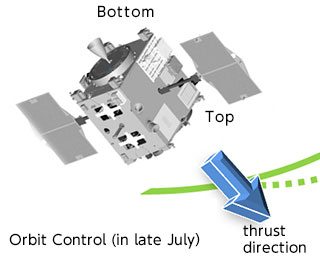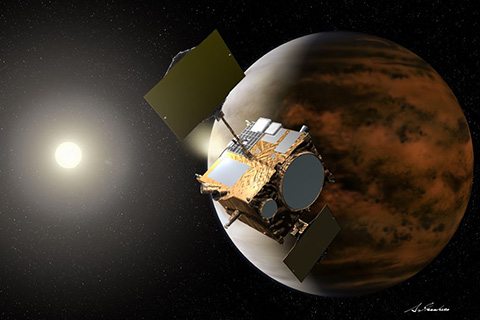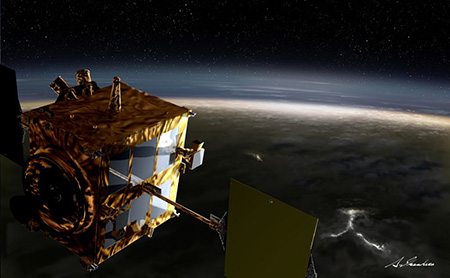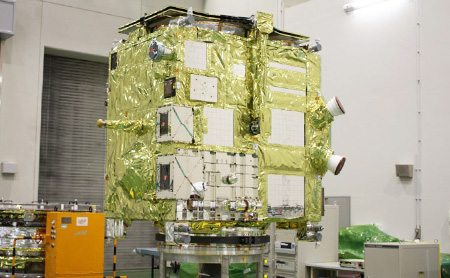Aug. 5, 2015 Updated
AKATSUKI: Orbit successfully controlled
 |
JAXA performed an orbit control maneuver for the Venus Climate Orbiter “AKATSUKI” in late July in preparation for its re-injection into the Venus orbit scheduled for Dec. 7, 2015. According to the analysis of telemetry data acquired up to Aug. 2, the orbit control and correction was successfully conducted as scheduled by 5:30 p.m. on August 4. (All dates and time are Japan Standard Time.) … |
|---|
About Venus Climate Orbiter “AKATSUKI” (PLANET-C)
 (Courtesy of Akihiro Ikeshita) |
AKASTUKI will elucidate the mysteries of Venus, Earth’s twin sister.
|
|---|
Re-entry plan to Venus orbit
|
The AKATSUKI is expected to usher in a new era of Venusian exploration. It was launched aboard an H-IIA Launch Vehicle No. 17 in May 2010 (JST.) It smoothly flew and spurted out jets from its orbit control engine on Dec. 7, 2010. Unfortunately, the AKATSUKI failed to inject itself into the orbit of Venus. JAXA set up an investigation team not only to examine and study the causes of the failure and countermeasures, but also to see if it is possible to insert the AKATSUKI again into the orbit when it comes closer to Venus in about six years. |
 |
|---|
Characteristics of Venus Climate Orbiter “AKATSUK” (PLANET-C)
Infrared light enables more detailed investigation of Venus.
|
The probe vehicle of AKATSUKI will enter an elliptical orbit, 300 to 80,000 km away from Venus’s surface. This wide variation in distance will enable comprehensive observations of the planet’s meteorological phenomena and of its surface, as well as observations of the atmospheric particles escaping from Venus into space. It will also be possible to take close-up photos of Venus, and to observe the storm winds that blow on the Venusian surface, at speeds that reach 100 m a second – 60 times the speed at which Venus rotates. This phenomenon remains the biggest mystery of Venus, as it cannot be explained meteorologically. AKATSUKI will employ infrared light to observe and elucidate the mysteries surrounding the atmosphere under the clouds and the conditions on the planet’s surface. In addition, it will confirm the presence of active volcanoes and thunder. |
 |
|---|
Major Characteristics
| International Designation Code | 2010-020D |
|---|---|
| Launch Date | 6:58, May 21, 2010 (JST) |
| Launch Vehicle | H-IIA Launch Vehicle No.17 |
| Location | Tanegashima Space Center |
| Shape | Box shape with two wing-type solar array paddles |
| Weight | Mass at liftoff: about 500 kg |
| Orbiter | Venus elliptical orbit |
| Altitude | PeriVenus: 300 km ApoVenus: about 80,000 km |
| Orbital Inclination | Approx. 172 degrees |
| Orbital Period | Approx. 30 hours |
Mission talk by team leaders
This entry passed through the Full-Text RSS service – if this is your content and you’re reading it on someone else’s site, please read the FAQ at fivefilters.org/content-only/faq.php#publishers.
Comments are closed.